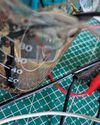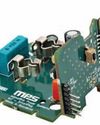INTERNET From The Sky
Electronics For You
|July 2023
Unbounded by traditional ground infrastructure, satellite internet delivers broadband internet to places where access has been unreliable or completely unavailable. All that is needed is a small satellite dish to receive the signal and pass the bandwidth on to your router. A new space race is on and this time it is all about the internet

Space based internet systems have been in use since last many years, facilitated by geostationary satellites at a staggering 35,786km height above the equator that zip at about 11,000km per hour. Signals beamed from the satellites cover about one-third of the Earth's surface; hence three to four satellites can cover the entire planet.
However, a significant time lag, called latency, of about 600 milliseconds occurs between seeking the data and receiving it. Satellite internet using lower Earth orbit (LEO) satellites reduces the latency to 20-30 milliseconds, which is close to that of terrestrial systems.
To go around the Earth every few hours and balance the effect of gravity, the speed of LEO satellites should be more than double the speed of geostationary satellites, as a result their visibility at any location is reduced and many satellites are needed to cover the complete surface of Earth. Starlink is expected to deploy as many as 42,000 satellites at altitudes of 350km to 1,200km.
The satellite internet provides consistent signals with high speed and low latency to preclude annoyances, such as dropped calls and lost or delayed signals. Satellite internet is most suitable for areas where it is not feasible or viable to lay cables or set up transmission towers due to inaccessible terrain and high costs.
How satellite internet works
Satellite internet connections are provided by an array of interlinked small sized satellites moving in LEO. This array beams the internet signals down to transreceivers located on ground.
このストーリーは、Electronics For You の July 2023 版からのものです。
Magzter GOLD を購読すると、厳選された何千ものプレミアム記事や、10,000 以上の雑誌や新聞にアクセスできます。
すでに購読者ですか? サインイン
Electronics For You からのその他のストーリー

Electronics For You
Tech Majors Are Racing TOWARDS NET-ZERO - What About You?
Apple, Microsoft, Amazon, Google, Infosys, Wipro—global and Indian firms are heading closer to achieving net-zero emissions, a mandate to combat climate change. Here is what you need to know to start your journey...
12 mins
December 2025

Electronics For You
Miniature IoT WATER TDS And LEVEL MONITOR Cum CONTROLLER
For setups that rely on stored water, clear awareness of tank level and water quality is essential.
3 mins
December 2025

Electronics For You
The Impact Of GENERATIVE AI On The Future Of AUTOMOTIVE AND EVs
Autonomous vehicles, connected ecosystems, and smart factories are only the beginning. Generative Al is pushing the auto industry beyond predictions into a bold era of creativity-from EV design to real-time diagnostics and showroom automation. Here is how GenAl is reshaping innovation across the automotive value chain.
8 mins
December 2025

Electronics For You
How AI Tools Are Making SOFTWARE DEVELOPMENT BETTER
AI is reshaping how we code, debug, and collaborate. From Copilot to automation, it is changing software development in ways worth exploring.
3 mins
December 2025
Electronics For You
How AI Tools Are Making SOFTWARE DEVELOPMENT BETTER
AI is reshaping how we code, debug, and collaborate. From Copilot to automation, it is changing software development in ways worth exploring.
3 mins
December 2025

Electronics For You
5 Interesting Reference Designs FOR SMART HOMES
Smart home devices are transforming the way people interact with their appliances. They make homes more convenient, secure, and energy-efficient. From smart plugs and energy monitors to smart locks and thermostats, reference designs help design engineers create connected products that are easy to use, consume less power, and are reliable. These designs allow you to control devices remotely, track energy use, extend battery life, and automate routines. They provide practical solutions for upgrading homes and small commercial spaces without major modifications.
3 mins
December 2025

Electronics For You
Fancy USB LED VASE
This USB LED vase is a simple yet elegant device that fuses art with electronics to create a decorative lighting display. Powered directly from a standard USB port, it uses readily available components such as MOSFETs, resistors, capacitors, and LEDs to produce a striking, dynamic sequence of lights.
3 mins
December 2025

Electronics For You
"WHAT OTHERS SELL IN FOUR BOXES WE BUILT IN ONE"
Years of custom field work are shaping a product line with its own cloud, its own hardware, and a market that is now beginning to recognise its value.
8 mins
December 2025

Electronics For You
BUILD LARGE LANGUAGE MODELS
Large language models are machine learning models designed for a range of language-related tasks such as text generation and translation. Here’s how open source software can help you build your own large language model.
6 mins
December 2025

Electronics For You
Rare Earth Or Rare Ingenuity? India Remains Between The Two
With China firmly controlling rare earth exports, India confronts a critical moment in its technological trajectory.
8 mins
December 2025
Translate
Change font size

